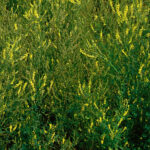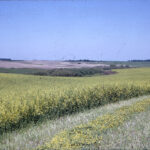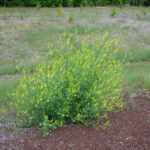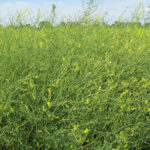Sweet Clover
Melilotus officinalis and Melilotus albus
General Description
Sweet clover is a widely adapted biennial (grows two years) found across North America from roadsides, to fertile cropland to invading native prairie. Two different species are often grouped together (including in U-Pick) as they have many similar characteristics. White flowered sweet clover (Melilotus alba) has coarse stems and flowers 10-14 days after yellow flowered. Yellow flowered sweet clover (Melilotus officinalis) tends to be shorter, finer stemmed and is considered to be more drought tolerant. Some sources indicate it is potentially more winter hardy.
Sweet clover grows on average 1 m (3 ft) tall in its first year and 1.5 m (5 ft) tall in its sceond year. Many branched stems make up each plant. Leaves are made up of three oblong toothed leaflets which attach to the branched stems with short stalks. Sweet clover has yellow or white spike-like flower clusters. Sweet clover can cause bloat in livestock. Use a low coumarin variety of sweet clover when haying to avoid sweet clover disease (Dicoumarol from a moldy plant interferes with blood clotting in livestock). Volunteer sweet clover plants are common.
Type
Tame legume.
Origin
Turkey, Siberia, Spain. Canadian varieties have been developed.
Longevity
Biennial. Sweet clover can reseed itself for some stand persistence.
Use
Pasture, hay. Most commonly used for plow-down green manure crops to improve soil organic matter.
Optimal Time of Use
Summer. In the year of establishment, a late fall grazing may be possible after roots have established. Graze sweet clover in the late vegetative stage to maximize palatability and feed quality. Cut sweet clover at the bud to very early bloom stage for the best quality hay. If cut late, sweet clover hay is very stemmy, loses leaves and is unpalatable.
Recovery After Use
Requires 60-80 days of recovery. In the establishment year leave at least 12 in (30 cm) of stubble after use to enhance stand survival. If two cuts of hay are desired in the second year of production, cut at 12 in (30 cm) during the first cut. Stem buds between ground level and 12 in are needed for the sweet clover plant to regrow. Frequent, light rotational grazing is successfully used with sweet clover.
In the establishment year leave at least 12 in (30 cm) of stubble after use to enhance stand survival. If two cuts of hay are desired in the second year of production, cut at 12 in (30 cm) during the first cut. Stem buds between ground level and 12 in are needed for the sweet clover plant to regrow. Frequent, light rotational grazing is successfully used with sweet clover.
Palatability/Nutritional Value
Sweet clover is palatable in the vegetative through the bud stage but palatability decreases as it matures. Yellow sweet clover has an average digestibility of 58% and crude protein of 16% in the early bloom stage. Sweet clover can cause bloat in livestock. Use a low coumarin variety of sweet clover when haying to avoid sweet clover disease (Dicoumarol from a moldy plant interferes with blood clotting in livestock).
Annual Precipitation min/max (mm)
230mm / 1524mm
Drought Tolerance
High tolerance.
Flooding Tolerance
Sweet clover can withstand 1-2 weeks of spring flooding.
Winter Hardiness
Good to excellent winter hardiness. Sweet clover is only a biennial despite hardiness.
Soil Texture Preference
Sweet clover is suited to all soil textures (sandy, loamy, clay), but produces best on fertile clay to clay loam soils.
Erosion Control
Sweet clover has up to moderate ability to reduce erosion, depending on the soil zone. Sweet clover can be used as a plow down crop to add organic matter and nitrogen to the soil.
Salinity Tolerance
Moderate tolerance.
Acidity Tolerance
No acidity tolerance.
No acidity tolerance. pH of 6.6 or higher.
Alkalinity Tolerance
Moderate tolerance.
Seeds per kg
570,000 seeds/kg (259,000 seeds/lb)
Suggested Mixtures
Can be used as a short lived component of a forage mixture. Often seeded to provide cover to other seedlings during establishment or for some production in the establishment year and year after. Avoid high seeding rates in a mix, as sweet clover is very competitive and is only a biennial.
Ease of Establishment
Sweet clover seedlings establish easily. It grows best with little competition. Seeding sweet clover very early in the spring allows for it to establish well enough to overwinter the first year. Sweet clover has a high hard seed count and should be scarified before seeding.
Competitiveness
Sweet clover is competitive with weeds once established. Sweet clover has become invasive and naturalized across North America. Once established and setting seed, it can be difficult to control unless seed set is controlled.
Management Considerations
When haying, choosing a low coumarin variety is important to eliminate the risk of sweet clover disease (bleeding) in livestock. Inoculate and scarify sweet clover seed prior to seeding. Allowing only light fall use in the year of establishment will allow for maximized production the second year. Conduct a soil test at the beginning of the second year and fertilize accordingly to maximize sweet clover production.
Saskatchewan Dryland Forage Species Adaptation Tool, USDA Plants Database, Alberta Forage Manual, Manitoba Forage Adaptation and Comparison Guide
Saskatchewan Dryland Forage Species Adaptation Tool, USDA Plants Database, Alberta Forage Manual, Manitoba Forage Adaptation and Comparison Guide, Publication 30-OMAFRA
Sweet clover grows on roadsides throughout the region demonstrating its wide adabtibility and persistance in unculitvated areas. Second year plants can provide late fall grazing.
Sweet clover grows on roadsides throughout the region demonstrating its wide adaptibility and persistance in unculitvated areas. Second year plants can provide late fall grazing.



